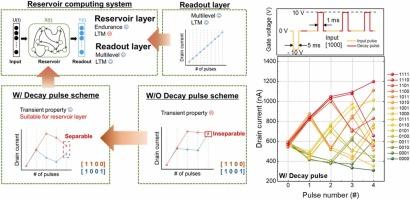Physical reservoir computing system fully implemented using a single flash memory device via tailored decay pulse modulation
IF 17.1
1区 材料科学
Q1 CHEMISTRY, PHYSICAL
引用次数: 0
Abstract
With the rapid expansion of artificial intelligence (AI) applications, developing energy-efficient hardware capable of processing temporal data has become increasingly critical. In this work, we present a physical reservoir computing (RC) system fully implemented using a single TiN/Al2O3/Si3N4/SiO2/poly-Si (TANOS) flash memory device. Unlike prior approaches that rely on multiple or heterogeneous devices, our system uniquely realizes both the reservoir and readout functionalities within a single device platform. By applying a tailored decay pulse scheme, we induce short-term memory (STM)-like dynamics in a device traditionally known for long-term memory (LTM), enabling dynamic reservoir state evolution essential for temporal signal encoding. The TANOS device demonstrates excellent endurance (>105 cycles), low gate leakage (~10.06 nA), and high device uniformity, supporting reliable and low-power operation, with the operation possessing the highest energy consumption (erase) consuming only 513.1 pJ per pulse at room temperature. When integrated into a CNN-based RC framework, the system achieves a high classification accuracy of 88.38% on the Fashion MNIST dataset and maintains strong performance in a fully hardware-oriented MNIST simulation. These results highlight the potential of standard silicon memory technology for building compact, energy-efficient, and fully self-contained neuromorphic computing systems, paving the way for scalable and CMOS-compatible AI hardware using a single memory device.

物理储层计算系统完全实现使用单个闪存设备通过定制衰减脉冲调制
随着人工智能(AI)应用的迅速扩展,开发能够处理时间数据的节能硬件变得越来越重要。在这项工作中,我们提出了一个物理储层计算(RC)系统,该系统完全使用单个TiN/Al2O3/Si3N4/SiO2/多晶硅(TANOS)闪存器件实现。与之前依赖于多个或异构设备的方法不同,我们的系统在单个设备平台内独特地实现了储层和读出功能。通过应用定制的衰减脉冲方案,我们在传统上称为长期记忆(LTM)的器件中诱导类似短期记忆(STM)的动态,从而实现对时间信号编码至关重要的动态储层状态演化。TANOS器件具有优异的耐用性(105个周期),低栅极漏(~10.06 nA)和高器件均匀性,支持可靠和低功耗的工作,在室温下具有最高的能量消耗(擦除),每脉冲仅消耗513.1 pJ。当集成到基于cnn的RC框架中时,该系统在Fashion MNIST数据集上实现了高达88.38%的分类准确率,并且在完全面向硬件的MNIST仿真中保持了较强的性能。这些结果突出了标准硅存储技术在构建紧凑、节能和完全独立的神经形态计算系统方面的潜力,为使用单个存储设备的可扩展和cmos兼容的AI硬件铺平了道路。
本文章由计算机程序翻译,如有差异,请以英文原文为准。
求助全文
约1分钟内获得全文
求助全文
来源期刊

Nano Energy
CHEMISTRY, PHYSICAL-NANOSCIENCE & NANOTECHNOLOGY
CiteScore
30.30
自引率
7.40%
发文量
1207
审稿时长
23 days
期刊介绍:
Nano Energy is a multidisciplinary, rapid-publication forum of original peer-reviewed contributions on the science and engineering of nanomaterials and nanodevices used in all forms of energy harvesting, conversion, storage, utilization and policy. Through its mixture of articles, reviews, communications, research news, and information on key developments, Nano Energy provides a comprehensive coverage of this exciting and dynamic field which joins nanoscience and nanotechnology with energy science. The journal is relevant to all those who are interested in nanomaterials solutions to the energy problem.
Nano Energy publishes original experimental and theoretical research on all aspects of energy-related research which utilizes nanomaterials and nanotechnology. Manuscripts of four types are considered: review articles which inform readers of the latest research and advances in energy science; rapid communications which feature exciting research breakthroughs in the field; full-length articles which report comprehensive research developments; and news and opinions which comment on topical issues or express views on the developments in related fields.
 求助内容:
求助内容: 应助结果提醒方式:
应助结果提醒方式:


